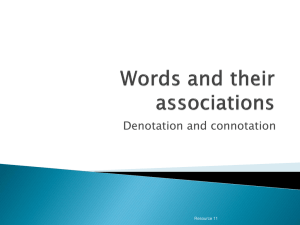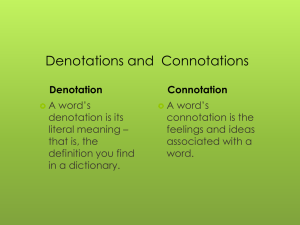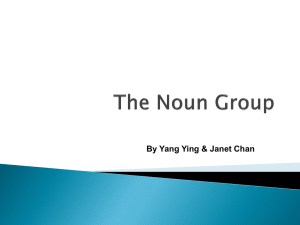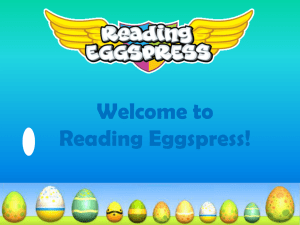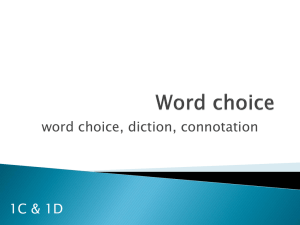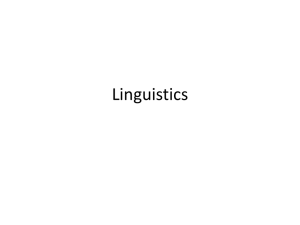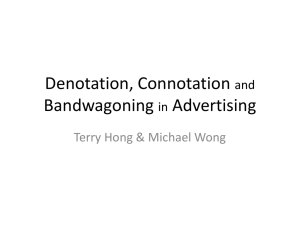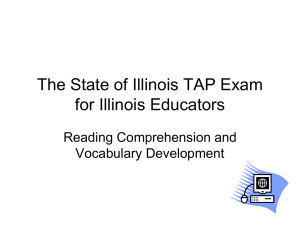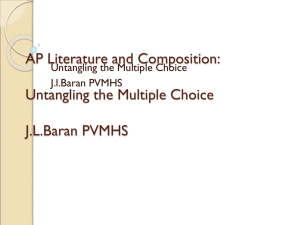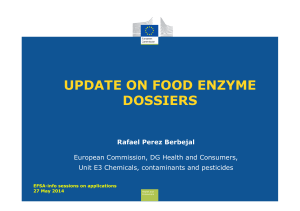LOGIC IN GENERAL
advertisement
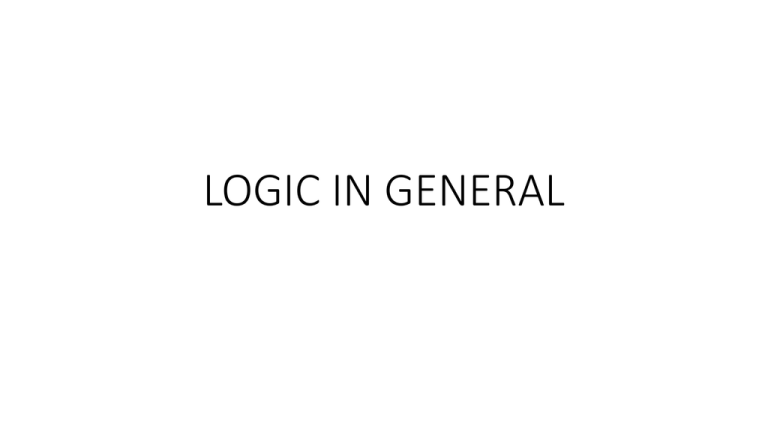
LOGIC IN GENERAL TOPICS I. II. III. IV. Definitions Truth and Meaning Material and Formal Objects of Logic Ideas & Terms LOGIC: Definitions The science of correct reasoning • As a Science: the Systematic Body of Knowledge of Reasoning • Can be Verified/Validated, Replicated, & Accounted for Man as Homo sapiens sapiens: Humans with Creativity & Imagination • • • • REASON: that which concerns itself to know things INTELLECT: faculty that allows Reason to arise & flourish Reason + Intellect = THINKING Thinking + Analytical Perspective = CRITICAL THINKING TWO TYPES • Natural Logic: the innate natural order of correct thinking • Biological Functions • Scientific Logic: the systematic way of reasoning to examine thought processes in difficult or controversial cases • • • • • Debate Theorizing Philosophizing Reflection Contemplation BRANCHES FORMAL LOGIC • Symbolic Logic, only concerned with the correctness rather than the truth of a logical process • Concerns itself with the FORM rather than the SUBSTANCE of the argument MATERIAL LOGIC • Critical Thinking, concerned with the Truth, the substance of the argument • Establishes connection between thought-contents & reality to arrive at the conclusion 3 DIVISIONS I. SIMPLE APPREHENSION: the intellect grasps the meaning of something (passively taking hold of something without affirmation or denial) II. JUDGEMENT: the mental operation that pronounces the identity or non-identity between ideas III. REASONING: mental creation which proceeds from a previously known truth to a new truth IDEAS & TERMS SIMPLE APPREHENSION • Grasping and abstracting the essence/meaning of things without denial or affirmation • 2 Types of Meanings: Connotation(Symbolic) and Denotation(Literal) • IDEA: mental product of apprehension • TERM: verbal manifestation of an Idea IDEAS SENSE DATA IMAGE COMPREHENSION = IDEAS SENSE DATA: experience through the senses IMAGE: representation of the conscious experience; reflects the sensible aspects of reality COMPREHENSION: identifying the nature of the experience by identifying the essential elements; divided into CONCRETE(that which is perceived through the senses), and ABSTRACT(that which is universal in scope of meaning) IDEA: a mental sign to grasp the essence of something; considered as abstract; CONCEPTS TERMS The need to communicate the Abstract The importance of understanding the Abstract TERM: the verbal manifestation of an Idea; a conventional sign that is expressive of an idea • SIGN: a recognizable connection between it and the entity/object to be known; something that leads to the knowledge of something else • CONVENTIONAL SIGN: an arbitrary sign which results from the ‘common agreement’ among men; contra Natural Sign, where the connection with the object that is represented is given by nature • EXPRESSIVE of an idea: makes the abstract understandable via Language; Terms serve to articulate Ideas MEANINGS: The Logical Properties of Terms CONNOTATION • Indicates the meaning, the substance of something • Aka intention, signification, or comprehension DENOTATION • Refers to something; the literal side of a term • Relationship: Inversely-Proportional, as Connotation increases, Denotation decreases, & vice versa CLASSIFICATION OF TERMS I. According to COMPREHENSION II. According to EXTENSION III. According to ORIGIN IV. According to RELATION V. According to MEANING VI. According to QUALITY VII. According to OBJECT According to Comprehension 1. SIMPLE: expresses one conceptual note • Truth: conformity between intellect and object • Being: an existential thing • Falsity: non-conformity between intellect and object 2. COMPOUND: expresses more than one conceptual note • E.g. Man, God, etc. 3. CONCRETE: expresses something which has attributes that can be perceived by the senses • E.g. Ball, Desk, Table, etc. 4. ABSTRACT: expresses something that is separated from any single object; a pure idea expressed in words • E.g. Love, Perfection, Good, Evil, etc. Note: A term or idea can be both Concrete & Abstract According to EXTENSION 1. SINGULAR: represents one single object only. • Proper Nouns: Names, Places, etc. • Indicators: This dog, That face, My family 2. UNIVERSAL: represents not only a class as a whole but also each member of the class • Quantifiers: All, Everyone, Each, Nobody, Nothing, etc. • E.g. Plants, Girl, Boy, Chair, Table 3. PARTICULAR: represents only a part of the Universal whether it is definite or indefinite • Not a whole; not referring to one, but refers to a part, or percentage • E.g. Many(2 out of 10), Some(3 out of 10), Few, Several, Majority 4. COLLECTIVE: represents a number of things constituting a group or whole; indicates a sum or aggregate and not as individual & unrelated units • E.g. Family, Society, Choir, Humans, etc. According to ORIGIN 1. IMMEDIATE: Intuitive, formed via direct perception of things • E.g. whistle, chair, chirping, falling rain, doll 2. MEDIATE: Abstractive, formed via mediation of other ideas • E.g. God, Life, Philosophy, Soul According to RELATION 1. COMPATIBLE: terms that can co-exist in a subject • E.g. wise and good, hot and spicy, rich and famous, young, wild, & free 2. INCOMPATIBLE: terms that cannot co-exist with one another; they exclude each other a) b) c) d) CONTRADICTORY CONTRARY PRIVATIVE CORRELATIVE INCOMPATIBLE TERMS A. CONTRADICTORY: mutually excluding each other; no middle ground: one affirms & the other denies • E.g. Just –Unjust, Valid – Invalid, Legal - Illegal B. CONTRARY: expresses extremes within the same class; there exists a middle ground • E.g. Rich – Poor, Beautiful – Ugly, Fast - Slow C. PRIVATIVE: opposing ideas: one expresses perfection; the other the lack thereof which ought to be possessed • E.g. Truth – Lie, Good – Evil, Hearing – Deafness, Light – Dark D. CORRELATIVE: opposing ideas with mutual correlation: one cannot be understood without the other; each term is dependent upon each other • E.g. Cause – Effect, Husband – Wife, Whole – Part Note: An Idea or Term can be both Privative and Correlative According to MEANING 1. UNIVOCAL: same meaning in several uses • E.g. Animal, Polygon when predicated after an example stays the same 2. EQUIVOCAL: several meaning through several uses a) b) Only in Pronunciation: dew – due, soar – sore, ill – eel In Pronunciation & Spelling: Ground (Noun & Verb), Hunk (Noun & Adjective), Trunk (Noun) 3. ANALOGOUS: meaning in some ways the same and in other ways different • E.g. God exists VS Man exists, Head of Family VS Head *AMBIGUOUS: one term, several meanings *VAGUE: no clear, distinct meaning; depends largely on context According to QUALITY 1. Positive in Form, Positive in Meaning (+,+) • E.g. Life, Justice, Truth, Freedom 2. Positive in Form, Negative in Meaning (+,-) • E.g. Death, Lie, Error, Sin, Cruelty 3. Negative in Form, Negative in Meaning (-,-) • E.g. Immoral, Illegal, Incompetent, Dishonest 4. Negative in Form, Positive in Meaning (-,+) • E.g. Immortal, Infinite, Independent, Sinless According to OBJECT 1. REAL: expresses something with existential qualities, whether positive or negative • E.g. Chair, Scandal, Enjoyment, Clarity 2. LOGICAL: used as a conceptual device to facilitate learning • E.g. , Predicate, Phyla, Classification, Division 3. IMAGINARY: has no correspondence in reality but is merely a fabrication of the mind • E.g. Unicorn, Flying Carpet, Batman
